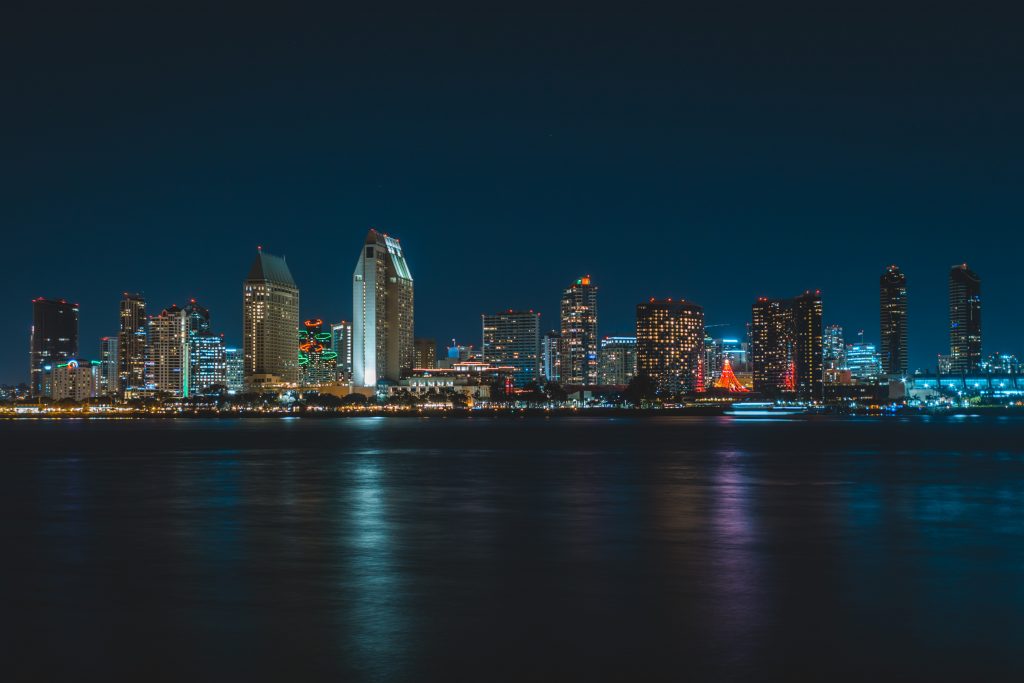
San Diego is the perfect destination for a girls’ trip. Its beaches and warm climate make it the perfect place for bachelorette parties, birthdays, and other trips! It has a rich culture and plenty of activities to keep you and your friends entertained.
San Diego
The border town of San Diego is a rich mix of Mexican and American cultures. The city’s Mexican influence is palpable wherever you go, and it has made this seaside destination one of Southern California’s most interesting places.
Like all border towns, San Diego’s soul is a reflection of the cross-cultural community who have called this place home. Take a walk through Chicano Park in the Barrio Logan neighborhood during the Día de Muertos (Day of the Dead), and the Mexican influence is even more remarkable than usual. During this time, altars are set up across the green lawns of the predominantly Chicano neighborhood, decorated to the hilt with sugar sculptures, marigold flowers, and the photographs of loved ones long gone.
Perhaps some of the people in the photographs were the ones who fought for Chicano Park in 1970 when the parkland was on the brink of becoming a highway patrol station. Or the ones who protested when the neighborhood’s access to the bay was cut off by the US Navy during World War II. The history of the local community is as woven into the foundation of Barrio Logan as the murals and public art that adorn every surface here. To truly see San Diego today is to understand and appreciate this sun and surf city’s Mexican roots, which have made this cultural hybrid one of southern California’s coolest spot
San Diego and Day of the Dead
San Diego comes alive during the Day of the Dead celebrations – which take place for over a week in November – especially in the historic heart of the city’s Old Town. For people of Mexican heritage across the world, the Día de Muertos is a time to remember and honor those who have departed. It is believed that people have three deaths: the first when you die, the second when your body is buried and back in the earth, and the last when the last person who remembers you on this earth has also died. As long as someone remembers you, you are still alive in memory.
Dive into the streets of Old Town, brimming with people dressed in vivid colors, and listen to the live music played among local families enjoying the holiday. Here, you can get your face painted to resemble La Caterina, the female skeleton that is one of the most recognizable symbols of Day of the Dead celebrations, before joining a candlelight procession as the sun dips over a glowing Californian sky.
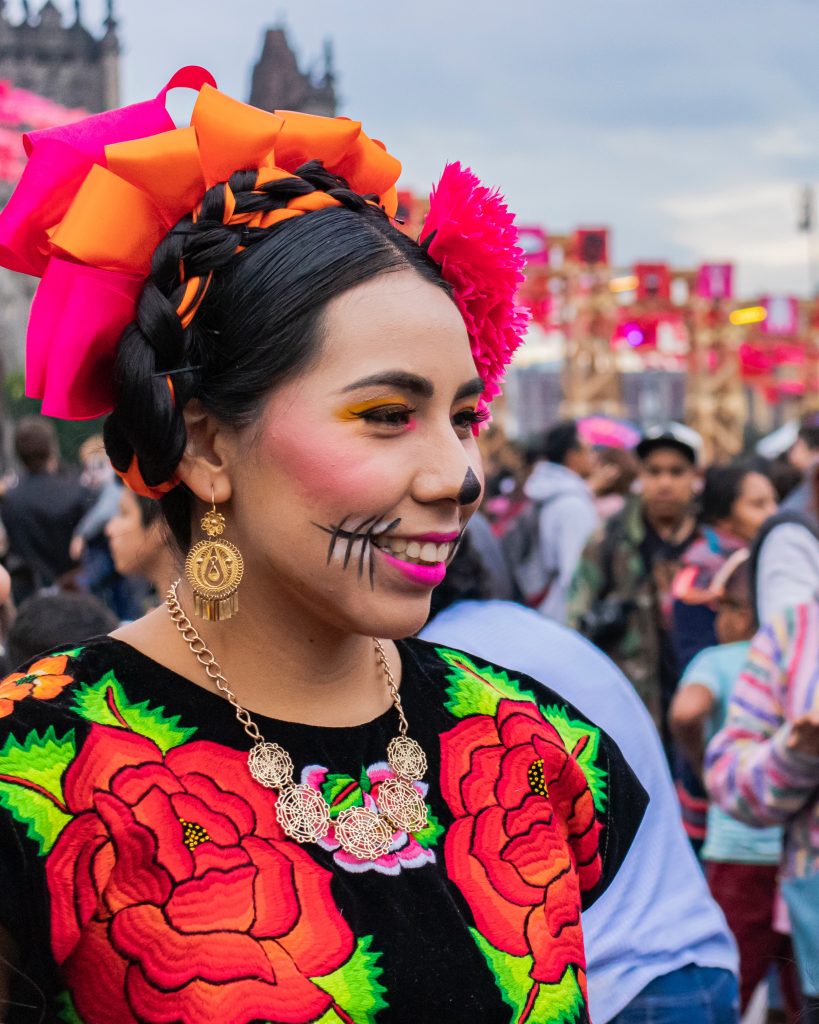
Barrio Logan
Barrio Logan is known primarily for its Latinx history It houses the largest collection of Chicano murals not just in California, but in the world. Special pieces of art flood the neighborhood—pieces like the mural. This mosaic piece was created by artist Betsy K. Schulz and elementary school students in 2012. It was crafted from clay pieces and found objects, depicting the community’s past and its hope for the future. The Mercado Mural mural was created to symbolize family and community -as well as honor those who have been in the neighborhood for generations.
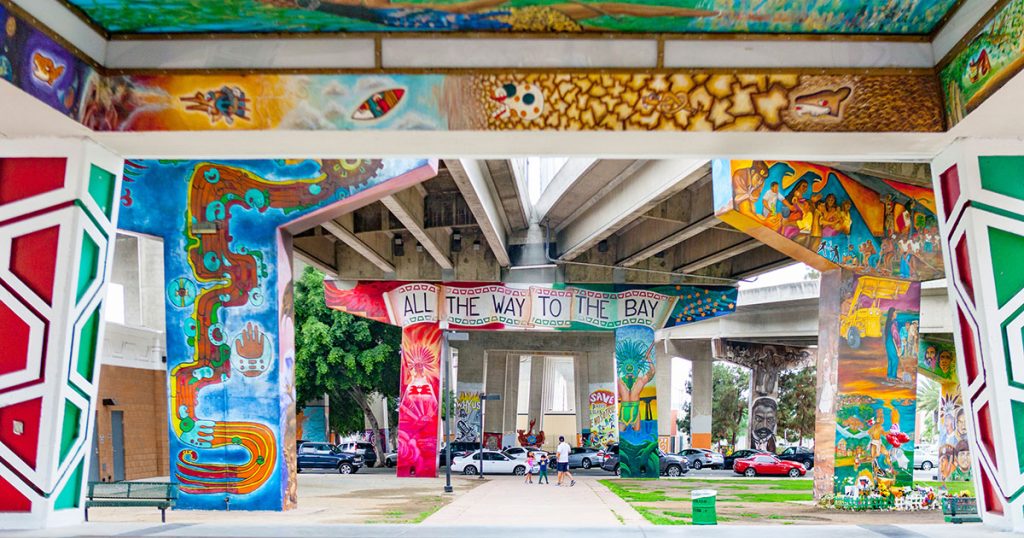
Things to do en El Barrio
When in the neighborhood, you’ll want to get a taste of Barrio Dogg. This Chicano comfort food joint serves Baja-style hot dogs out of a lowrider! Created as a champion for the Barrio Logan community, this local spot exists to provide soul-feeding comfort food to its customers. Another local favorite is Las Cuatro Milpas. Known for its homemade tortillas and picnic-style decor—and its yummy tamales—Las Cuatro Milpas offers a familiar Chicano taste with a family feel. Last up is ¡Salud!—a must-try taco spot serving up authentic Mexican street food. From its tattoo-inspired murals to its pinstriped car hoods on the walls, this local hotspot is the pinnacle of Southern California Mexican-American culture.
Who doesn’t love an ice-cold beer? Barrio Logan is home to several local breweries, where you can sip and savor a pint or two. First up: Mujeres Brew House. With a mission to educate and empower those who love craft beer, Mujeres is a family- and pet-friendly spot. You can enjoy Mujeres with a craft beer and a michelada bar.
Be sure to check out their seasonal favorites! Next up: Border X Brewing. This local taphouse stands for community, culture, and local craft beer. Not to mention, they bring in a rotating roster of local food trucks. Every Tuesday, Border X has Loteria night at 7 p.m.! Bring your family for food, drinks, and prizes! And lastly, Thorn Brewing Co. has three local taprooms around San Diego, but the Barrio Logan location is the original. It features a 30-barrel brewhouse, canning line, and tasting room. With seasonal favorites, beer on tap, and a variety of canned options, Thorn is the place to go to knock one back
History of San Diego
Sparked by the Gold Rush, Northern California expanded explosively. Newcomers entered an area where the laws were a confusion of Mexican, American, and improvised codes, administered by officers and courts of the same description, drawing their powers from all manner of odd sources.
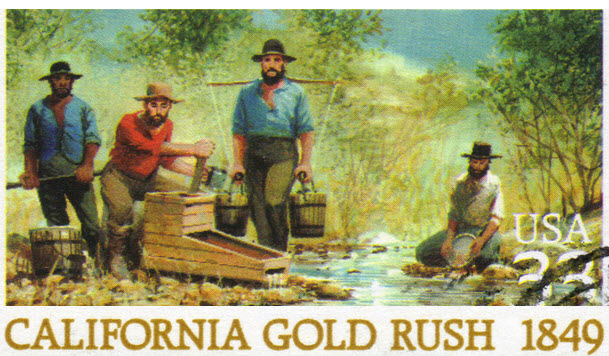
There had been no time to replace the military rule with territorial government by 1849, and the Gold Rush had brought enough population and problems to require statehood, so General Bennett Riley called together a constitutional convention in August. Miguel de Pedrorena and Henry Hill were chosen to represent San Diego and to have a part in assisting such great figures as John Sutter, Abel Stearns, Mariano Vallejo, Robert Semple, and William Gwin, in writing the constitution and setting the boundaries of the state. The constitution was accepted by the people of California in the first election under the American flag, and the state’s first governor, Peter H. Burnett, was chosen. Only after considerable political activity and maneuvering in Washington, D.C., which resulted in the Compromise of 1850, was California admitted. President Fillmore signed the bill on September 9, 1850.
The Split
San Diego County originally included all of Imperial County, most of Riverside and San Bernardino Counties, and the eastern half of Inyo County. The eastern boundary of California was the eastern boundary of San Diego County beyond the latitude of Monterey. The area was greater than that of the twelve states of the Union. In 1851 the San Bernardino and Inyo sections were cut off because they were too far from the county seat, and the county’s area came down to twice that of Massachusetts or New Jersey. Further reductions came in 1893, when Riverside County was created, and in 1907 when Imperial County broke away. The county’s area has since been slightly less than that of the State of Connecticut. Property in the county was valued at $500,000 in 1850; three-quarters of the value was in the little county seat.
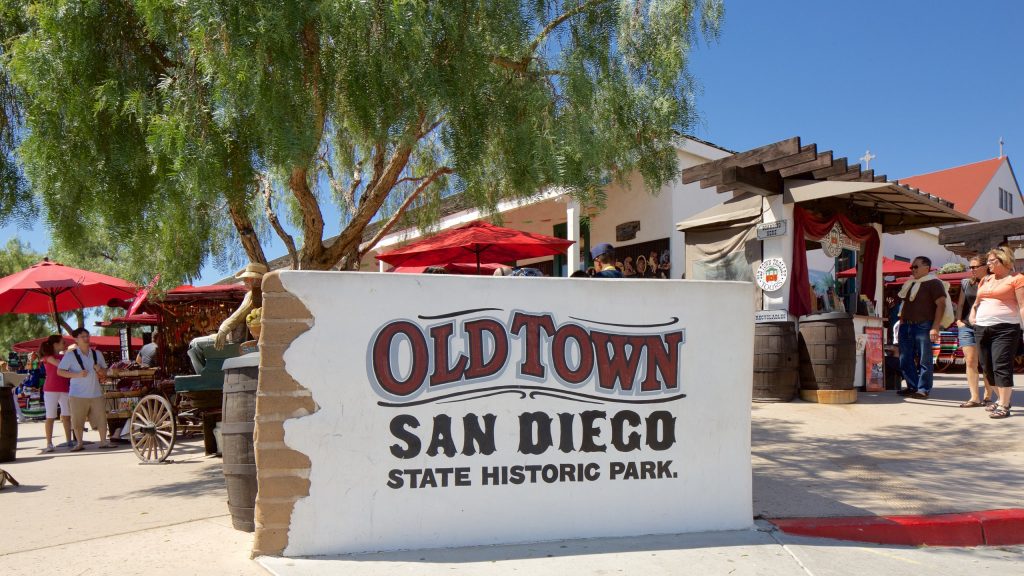
In the early 20th century the population of San Diego boomed. In 1900 the population of San Diego was less than 18,000. By 1940 it had risen to 203,000. In the second half of the 20th century, San Diego continued to flourish. Its population rose to 696,000 in 1970.
Meanwhile, the Maritime Museum was founded in 1948 and a new Public Library was built in San Diego in 1954. San Diego Air & Space Museum opened in 1963. SeaWorld opened in 1964. The Timken Museum of Art opened in 1965. The San Diego-Coronado Bay Bridge opened in 1969.
San Diego continued to prosper in the late 20th century. Fleet Science Center opened in 1973. Plaza Bonita opened in 1983. Horton Plaza opened in 1984. The Convention Center was built in 1989.
San Diego as a Naval Town
“Navy Town, USA,” is another nickname for San Diego. It is home to the US Navy’s Pacific Fleet. For veterans and military buffs, the aircraft carrier USS Midway (CV41) was the longest-serving US Naval carrier of the 20th century. She was in active service until 1992 and is now decommissioned and converted into the sees more than one million visitors annually. Today, you can explore 60 exhibits, see 29 restored aircraft, and complete a self-guided audio tour. Plan for about 3 ½ hours to complete the tour. The museum hosts about 400 active duty events annually, many of which the public is invited to observe. Adjacent to the Midway, you will have to get in line to take a picture of the iconic 25-foot “Unconditional Surrender” sculpture replicating the famously photographed embrace of a sailor and nurse celebrating the end of World War II in Times Square.
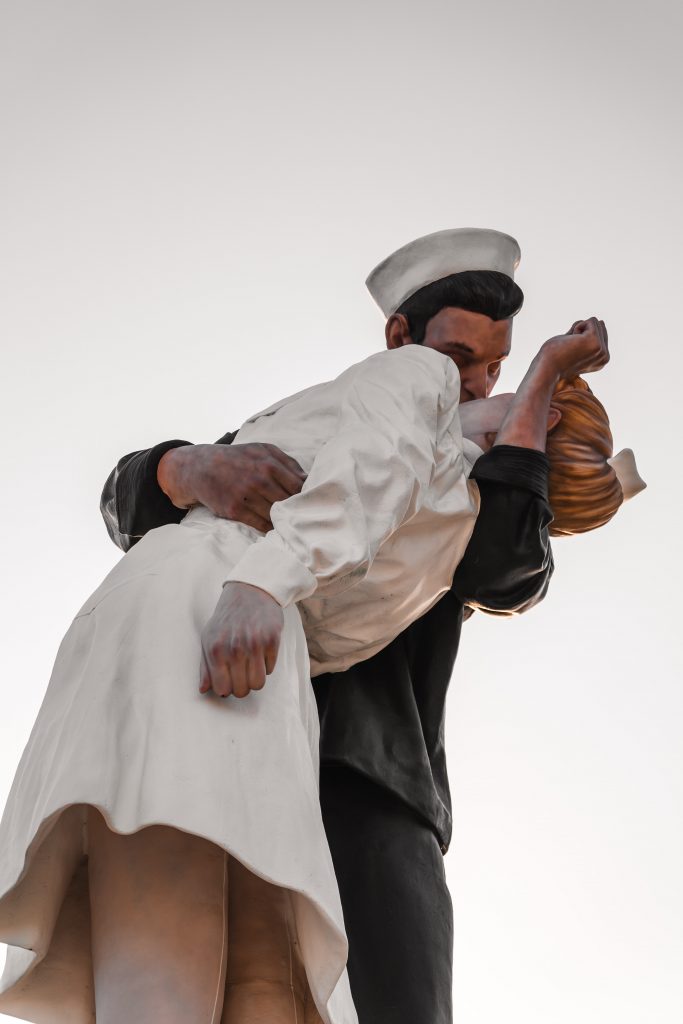
Fleet Week San Diego is usually in October. The mission of Fleet Week San Diego is to honor and celebrate the men and women of the military through public events that entertain and alliances that support and thank these heroes. There will be US Navy and US Coastguard ship tours, fly-overs, and many special events which thrill and inspire us; and make us proud to be American!
Views of the Harbor
For the best views of San Diego Bay, and to get the best view of the ships as they transit the harbor head out to Harbor Island, Shelter Island, or the Coronado Ferry Landing. Mondays and Fridays are usually the best days to view a ship in action.
A visit to San Diego is not complete without a harbor cruise. There are several choices and most offer a one or two-hour cruise. We recommend the two-hour cruise so that you get to see everything! The sea lions, the Point Loma Light House that was only operating for 36 hours, the USS Midway Museum, North Island Marine Naval Station, the Frigates and Destoyers, Coronado Island, Coronado Bay Bridge, and so much more.
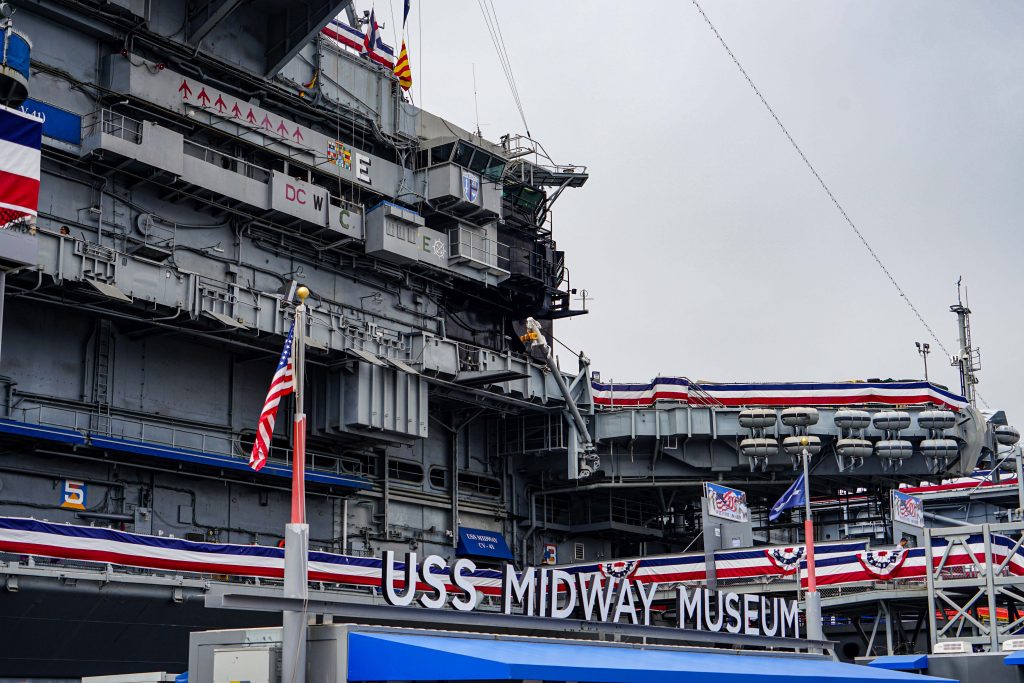
The property on which Naval Base San Diego (NBSD) is now located was deeded to the U.S. government by the city of San Diego in 1919 to build a docking and fleet repair base and commissioned in 1922. The property consisted of 21 water acres and 77.2 land acres with the former being mostly tidelands and marsh flats. After World War II, the name of the Repair Base was changed to Naval Station San Diego. The mission was expanded to support the ships of the Pacific Fleet. During the 90s, Naval Station San Diego became Naval Base San Diego when a realignment designated region commanders, including Navy Region Southwest. NBSD is homeport to more than 60 ships and 200 plus tenant commands, each with specialized missions and purposes.
Things to do in San Diego
If you are looking to do a girl’s trip whether it be a vacation or for a special occasion we have a list of things for you to do in San Diego.
La Jolla
The origin of how La Jolla (pronounced as La-HOY-a) got its name and history are unclear. The coastal community is often mistakenly referred to as San Diego’s ‘Jewel’. Scholars who researched La Jolla’s origin found no concrete answer to the meaning of La Jolla or exactly where it comes from. The only thing that is certain is that “La Jolla” is not Spanish for “The Jewel”.
La Jolla’s name is a somewhat controversial subject among town historians. No one knows where the name originated – whether it comes from the Spanish word La Joya (which means “the jewel”) or from the Indian term Woholle (meaning “hole in the mountains”), an appropriate name considering the caves and rock formations along La Jolla’s shoreline. The name has appeared in all land grant and mission records since 1928 and in scattered documents at least back to 1870 when they appeared spelled “L-a-J-o-y-a”.
From the crashing waves to the award-winning culinary creations, La Jolla sparkles with sights and attractions in a picturesque village where everything is immersed in casual, relaxed luxury.
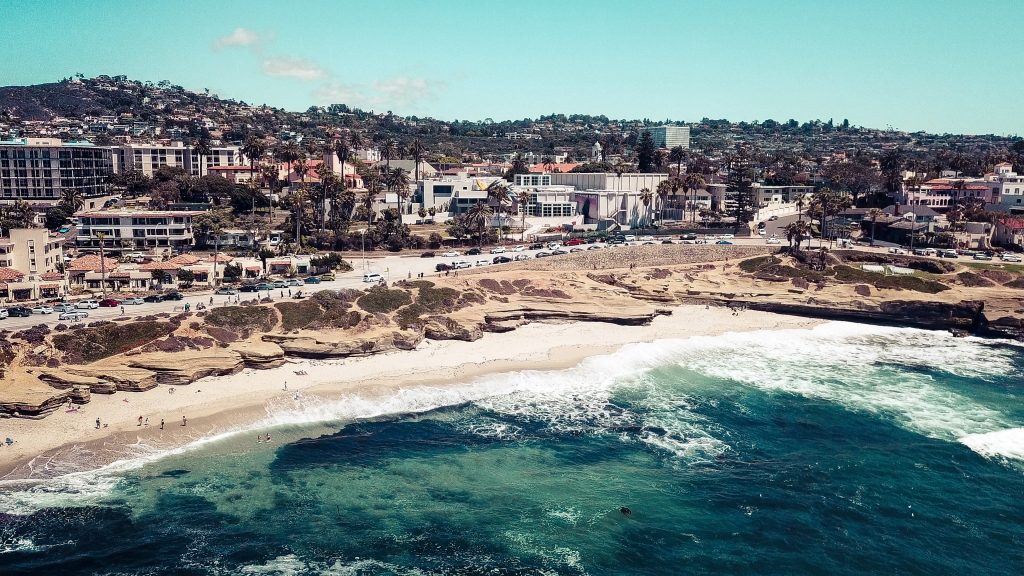
The Draw of La Jolla
With a dramatic coastline boasting incredible views, it’s no surprise that La Jolla is one of the most popular beach destinations in California. Surrounded on three sides by the sea and backed by the steep slopes of Mt. Soledad, La Jolla’s natural beauty, an abundance of activities and an upscale village lifestyle ensure that it lives up to its nickname as “the jewel” of San Diego.
Consistently voted one of the top beach destinations in the world, La Jolla offers a wide range of accommodations from luxurious hotels to casual coastal retreats, along with museums and art galleries, one-of-a-kind boutiques, great restaurants, and a slew of outdoor activities. Home to the famous Torrey Pines Golf Course and The Lodge at Torrey Pines, the scenic cliff area offers well-groomed hiking trails with spectacular views and world-class golf. At Torrey Pines Gliderport you can soar out over the beach cliffs on a hang glider or just relax and watch the action above.
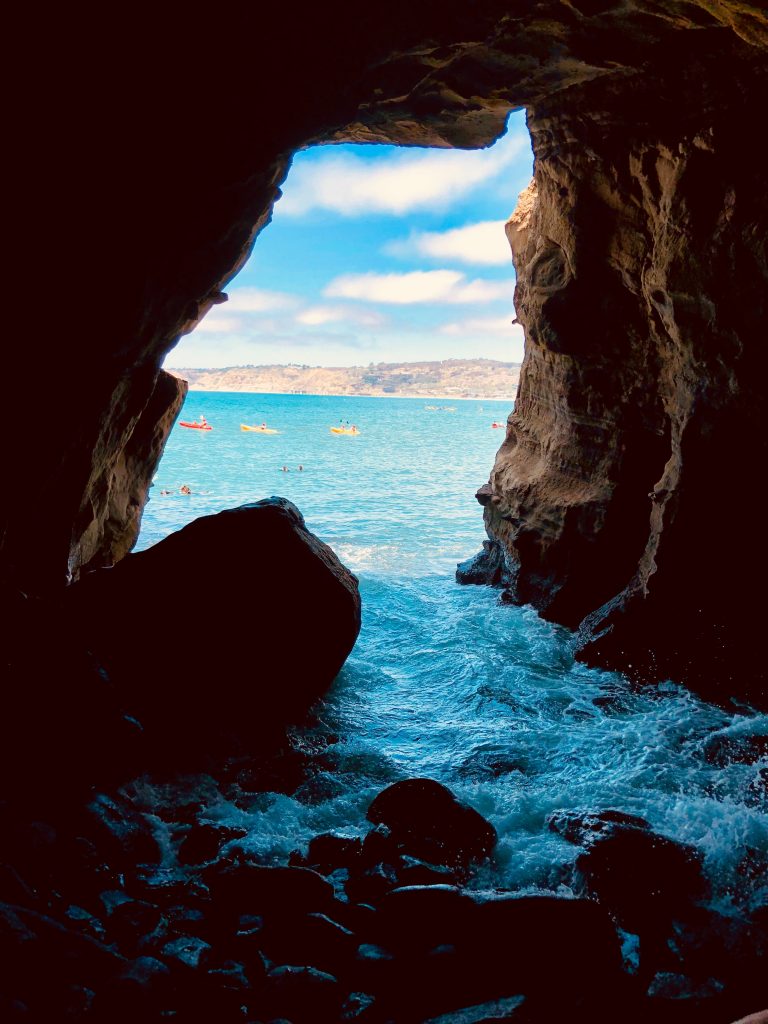
Along the dramatic coastline lies Scripps Park, where families can picnic throughout the summer while enjoying Fourth of July fireworks and concerts under the stars. Just south of the park is the Children’s Pool, where a seawall was originally built to protect kids from incoming waves but has been long taken over by a local seal colony. People are no longer permitted to swim here, but you can walk out along the seawall for a close-up view of the wildlife.
Other Attractions
La Jolla is also home to the Birch Aquarium at Scripps Institute of Oceanography and plenty of cultural attractions including the La Jolla Playhouse and the Museum of Contemporary Art, all situated in close proximity to The Village. The University of California San Diego, which hosts the popular Geisel Library and the Salk Institute for Biological Studies, are both located in La Jolla as well.
La Jolla’s biggest draw for locals and visitors alike is the beautiful beaches. During the summer and autumn months, the surf is relatively gentle, with warm waters in the 70s. Swimmers, snorkelers, scuba divers, kayakers, and surfers can enjoy the golden sands of La Jolla Shores, the Cove, and Windansea. And be sure to keep an eye out for migrating whales off the coast as they travel to and from Baja California.
San Diego Zoo
The San Diego Zoo is a 100-acre wildlife park and home to over 12,000 rare and endangered animals, representing more than 650 species and subspecies. Located just north of downtown San Diego in Balboa Park, the Zoo is also an accredited botanical garden, caring for more than 700,000 individual plants, including a prominent curated assemblage of close to 13,000 specimens, representing 3,100 species.
The San Diego Zoo grew out of exotic animal exhibitions abandoned after 1915 the Panama Exhibition. Dr. Harry M. Wegeforth founded the Zoological Society of San Diego. The Zoo was founded on October 2, 1916, and initially followed precedents set by the New York Zoological Society at the Bronx Zoo.
He served as president of the society until 1941. A permanent tract of land in Balboa Park was set aside in August 1921; on the advice of the city attorney, it was agreed that the city would own all the animals and the zoo would manage them.
The Zoo Moves
The zoo began to move in the following year. In addition to the animals from the Exposition, the zoo acquired a menagerie from the defunct Wonderland Amusement Park. Ellen Browning Scripps financed a fence around the zoo so that it could begin charging an entrance fee to offset costs. The publication ZooNooz commenced in early 1925. Me at the zoo, filmed in the San Diego Zoo, was the first video on YouTube, uploaded by Jawed Karim.
Animal collector Frank Buck went to work as director of the San Diego Zoo on June 13, 1923, signed to a three-year contract by Wegeforth. William T. Hornaday, director of the Bronx Zoo, had recommended Buck for the job, but Buck quickly clashed with the strong-willed Wegeforth and left the zoo after three months to return to animal collecting.
After several other equally short-lived zoo directors, Wegeforth appointed the zoo’s bookkeeper, Belle Benchley, to the position of executive secretary, in effect zoo director; she was given the actual title of zoo director a few years later. She served as zoo director from 1925 until 1953. For most of that time, she was the only female zoo director in the world. She was succeeded as director by Dr. Charles Schroeder.
The San Diego Zoo was a pioneer in building “cageless” exhibits. Wegeforth was determined to create moated exhibits from the start, and the first lion area at the San Diego Zoo without enclosing wires opened in 1922.
Until the 1960s, admission for children under 16 was free, regardless of whether they were accompanied by a paying adult.
Other Zoo Facts
The zoo’s Center for Reproduction of Endangered Species (CRES) was founded in 1975 at the urging of Kurt Benirschke, who became its first director. CRES was renamed the division of Conservation and Research for Endangered Species in 2005 to better reflect its mission. In 2009, CRES was significantly expanded to become the Institute for Conservation Research.
The world’s only albino koala in a zoological facility was born September 1, 1997, at the San Diego Zoo and was named Onya-Birri, which means “ghost boy” in an Australian Aboriginal language. The San Diego Zoo has the largest number of koalas outside of Australia.
In 2014, a colony of African penguins arrived for the first time in the zoo since 1979. They have since moved into Africa Rocks when it opened in 2017. In 2016, Baba, the last pangolin on display in North America at the time, died at the zoo.
Pacific Beach
Pacific Beach has dozens of boutiques, hotels, bars, clubs, restaurants, and casual cafes that line up along its picturesque boardwalk. This community is a haven for people who long for leisure, entertainment, and relaxation. It is adjacent to La Jolla, another beach community along San Diego’s shoreline. There are many activities, aside from frolicking on the beach and surfing. Its streets also teem with delicious food and vibrant nightlife. While visiting San Diego, don’t miss out on Pacific Beach.
Seaport Village
Downtown’s Seaport Village, awash in coastal breezes and views of Coronado Bridge, offers eclectic gifts and souvenirs. There are 50-plus diverse shops, 17 unique eateries, and four bayside restaurants. With four miles of meandering cobblestone pathways bordered by ponds, lakes, fountains, and colorful landscaping, plus a quarter-mile slate boardwalk along the San Diego Bay, it’s easy to enjoy an afternoon stroll while you wander through the shops, walking the promenade and taking in the scenery.
SeaWorld San Diego
Though you may spot wildlife at any one of San Diego’s beaches none put on quite as good a show as the performers at SeaWorld. Here, you’ll get to see a range of animals, including dolphins, California sea lions, California otters, and sea turtles, among others. As for the rides, travelers love the lightning-fast Manta roller coaster, but caution against the Journey to Atlantis or Shipwreck Rapids rides if you don’t want to get wet.
In 2022, the park added the Emperor, which it bills as the state’s tallest and fastest roller coaster with a 14-story vertical drop and speeds of up to 60 mph. For something a little more low-key, head to any one of the park’s animal exhibits, such as the underwater shark-viewing tunnel or the penguin habitat, which features nearly 400 penguins. There’s also the Sesame Street Bay of Play (included in your SeaWorld general admission ticket), which features various wet and dry playgrounds, as well as a bounce house, climbing structure, and smaller rides suited for children and toddlers.
Recent visitors had a blast at SeaWorld, especially those with kiddos in tow. Travelers say you can’t miss a show, with many being fond of the dolphin show in particular. But make sure to get there early though, as lines can get long. Travelers also highly recommended wearing quality walking shoes and bringing an extra jacket or change of clothes in case you get wet on the rides or at the shows (there’s a splash zone for most). Travelers who didn’t bring a change of clothes said they were miserable walking around the park wet and gawked at the high price of clothing available at the park.
Info Before Your Visit
Regardless of whether or not you purchase souvenirs, recent visitors say you should be prepared to spend some cash. Food is pricey, not to mention admission for single-day tickets for adults and children, which start at $109.99 if purchased online. Two- and three-day passes are also available. Upgrades involving up-close encounters with select animals are available and vary by animal. Parking is another expense to budget for; it’ll cost you $30 per car. To avoid that extra cost, consider taking public transportation; the park is accessible via city buses and trolleys. You’ll find SeaWorld San Diego about 7 miles northwest of the downtown area. SeaWorld is open year-round, but park hours fluctuate depending on the day and month; check SeaWorld San Diego’s website for the opening and closing times.
Belmont Park
A trip to San Diego is not complete without a visit to a beachfront amusement park and boardwalk Belmont Park. The park, which has been in operation since 1925, offers something for everyone. Those looking for a thrill can ride the iconic Giant Dipper Roller Coaster and the spinning Beach Blaster, while those who prefer something calmer can enjoy the carousel, go mini golfing or hit the arcade. Additional activities and attractions include rock climbing, bumper cars, zip lining, and laser tag. Despite the park’s busy location, previous visitors were pleased that the lines were usually short. However, they advise going in the morning or evening to minimize wait times regardless. Belmont Park also features a variety of retail shops and equipment rental vendors. Visitors also enjoy Plunge San Diego, the park’s indoor pool that features beach views.
Things in Belmont Park
Belmont Park serves typical amusement park fare (like hot dogs, ice cream, and burgers). The park is also home to a handful of upscale restaurants, including seafood and sushi spot Cannonball, which offers one of the city’s largest rooftops and overlooks Mission Beach.
Admission to the park is free, but visitors pay for rides and games as they go. If you purchase online, unlimited ride and game pass cost approximately $60 for adults and $55 for kids shorter than 48 inches; these provide access to games such as mini golf and laser tag. Free parking is available in surrounding lots. Belmont Park hours vary by season.
Mission Beach
Mission Beach – one of the top beaches in San Diego – is popular with families thanks to its variety of amenities and laid-back vibe. In addition to its approximately 2-mile-long boardwalk, the beach is also home to Belmont Park, a beachfront amusement park featuring arcades and numerous rides, including the Giant Dipper wooden roller coaster – a nearly 100-year-old National Historic Landmark. Mission Beach is also a great spot for beginner surfers (several surf schools offer lessons here).
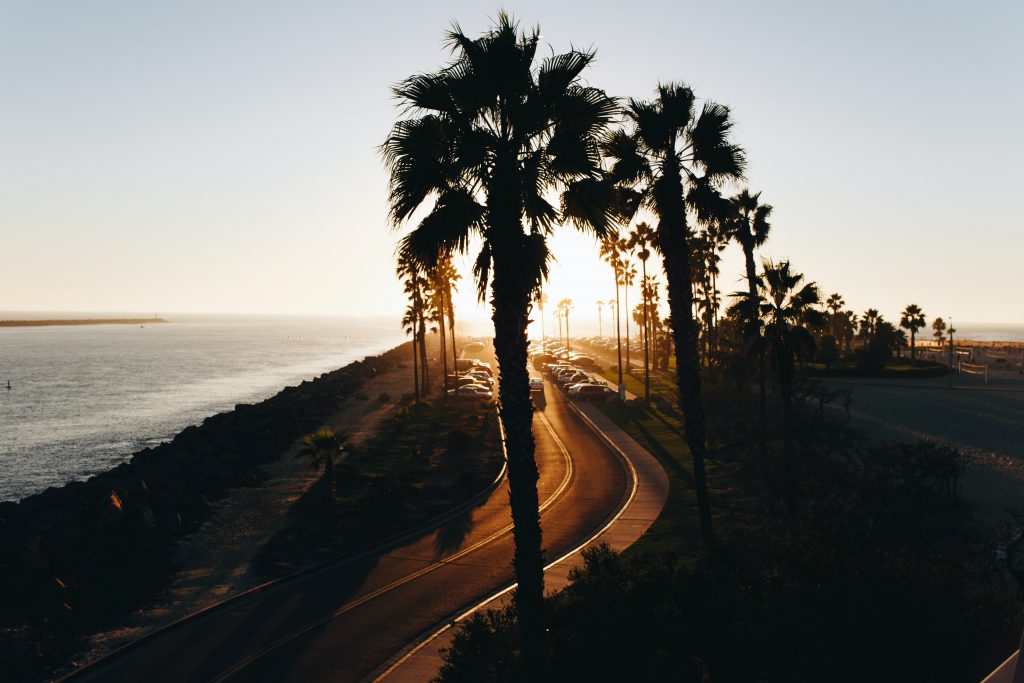
When lunchtime rolls around, head to one of the many beachside eateries that flank the boardwalk or Mission Boulevard (the area’s main thoroughfare), or have a picnic at Bonita Cove, the bayfront park located across the street from Belmont Park that also features a playground as well as several restrooms.
Other Attractions at Mission Beach
For the most kid-friendly atmosphere, heed the advice of past visitors and base yourself on the southern portion of Mission Beach. This part of the beach is quieter than the northern section (where the amusement park is located), and features beach volleyball courts, bathrooms, showers, and lifeguard stations. Reviewers suggest visiting Mission Beach in the morning to avoid the crowds and parking headaches that come with an afternoon visit. Others warn of homeless people loitering around the boardwalk. However, most were pleased with their experience and say it’s a great place for people-watching.
It is free to access Mission Beach. Visitors are generally welcome from 6 a.m. to dusk. Due to the beach’s popularity with tourists and locals, expect to drive around a little before finding a parking space, especially during the weekend. You can find more parking around Belmont Park, Santa Clara Point, and South Mission Beach Park. For more information, visit the city of San Diego website.
San Diego Night Life
San Diego is a humming, beautifully diverse city with a great quality of life. Without a doubt, America’s Finest City has a great nightlife scene. In fact, San Diego is in the top 10 on US News & World Report’s list of best nightlife cities. They describe San Diego’s nightlife scene as growing organically thanks to the city’s demographic and cultural diversity. The club scene here isn’t as fancy as Las Vegas, Manhattan, or Miami Beach, but it has an advantage—it’s more compact, relaxed, and laid-back.
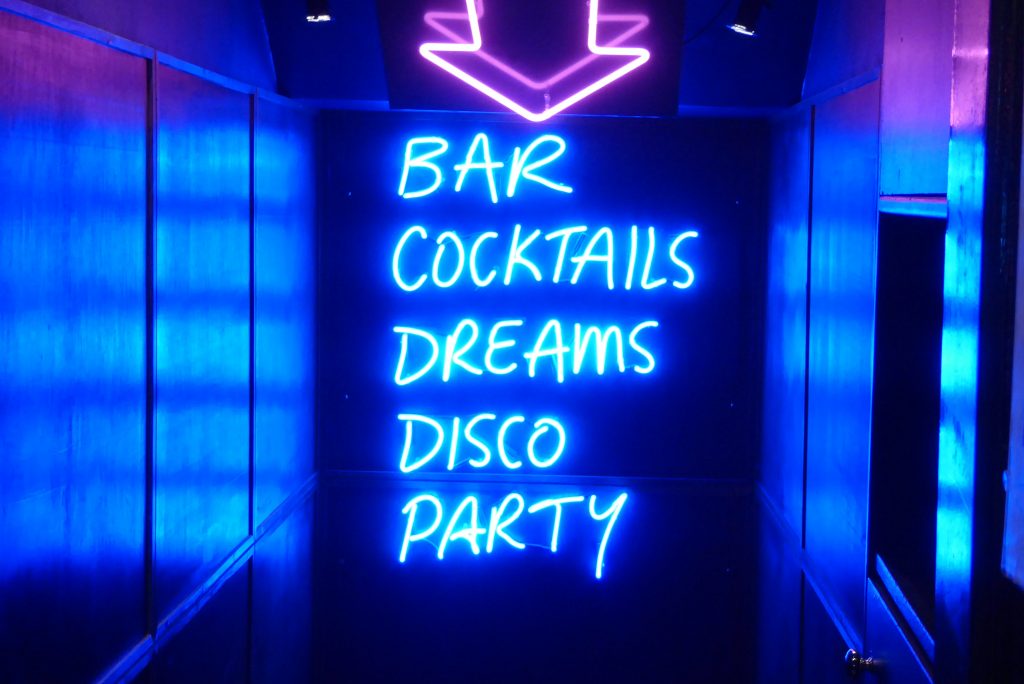
Downtown
While you can find tons of nightlife fun all across San Diego, your best bet is to stick to the downtown districts, especially the Gaslamp Quarter. Here, you can always find clubs, lounges, bars, pubs, and restaurants in the Cortez, East Village, Civic Core, Columbia, Marina, and Balboa Park districts.
Gaslamp Quarter
If you focus on this district alone, it’s easy to see why San Diego is one of the best American cities for nightlife. The Gaslamp Quarter covers 16 blocks, and it has more than 10 dance clubs, 50 bars, and close to 200 restaurants. This district is always the trendiest in the city, and it’s a historical neighborhood with lots of charm. A few tour operators in San Diego offer pub and club crawl activities that center entirely around Gaslamp nightclubs. If you’re coming for just a short visit, start at the Archway on Fifth Avenue just north of East Harbor Drive. From there, you can just start walking in any direction and find some great funky spots everywhere you go. No matter where you go, make sure one of your destinations is the Onyx Room Nightclub.
EDM Concerts and Raves
The most over-the-top EDM events and festivals take place at the former San Diego Sports Arena north of the airport, but you don’t have to go that far to catch the hottest DJs. A few of the large dance clubs in the Gaslamp have expanded to accommodate EDM and hip-hop fans when major artists come to perform.
Lounges
More than half of the hippest spots in the Gaslamp can be classified as trendy lounges that attract scene-makers, but the East Village district is starting to catch up. The East Village is where most of the recent residential and commercial development has been taking place in downtown San Diego, and it’s where a lot of new speakeasies, hookah lounges, and wine bars are set up shop.
When you’re up for some nightlife and looking for the best Latin and hip-hop clubs in San Diego, check out Onyx Room, a staple of the Gaslamp Quarter nightlife scene. With music genres including hip hop, top 40, urban Latin, reggaeton, bachata, salsa, merengue, regional, cumbia, and Banda, we have something to please everyone’s taste. You’ll fit right in with our open-minded, up-for-anything, and, above all, incredibly friendly crowd. Our inviting atmosphere and welcoming staff will ensure you have an experience unlike any other. To learn more about why Onyx Nightclub is the best San Diego nightclub, call us at 619-876-8044.
Why Girl’s Trips Are Important
As life goes on, and you get married and become a parent, friendships might take a backseat, even when it comes to people you’ve known for most or all of your life. Your friends, though, should still be there for you: whether you call them in the middle of the night because you’re frustrated with work, or whether you need to know which bar to hit. We all hope we won’t need to call in the middle of the night, but your listening-ear, bar-hopping friends make excellent travel companions. Who better to share a fun and relaxing week than someone who knows you, laughs with you, and had been there for you when you’ve really needed – you guessed it – a vacation.
Traveling with your girls is one of the best ways to unwind. Your girls, of course, will be there for your birthdays, and your bachelorette parties, and to support your wildest professional dreams. Where should you have your girls’ trip? It depends! If your crew is a rugged, outdoor-type clique, you’ll have plenty of places to hike and enjoy the fruits of mother nature in places like Arizona and New Hampshire through Everything Vacations. If you and your girls are the types that love the flashing lights and booming bass, you’ll find that Las Vegas, one of our favorite destinations, is a perfect fit. But don’t think that you can’t relax in Las Vegas, too – Sin City is a well-known golf and spa destination, and you could easily spend your days lounging in a warm, quiet place with a fluffy robe.

Female friendship is a powerhouse of support and camaraderie. As Nin suggests, a whole new world is opened up when a friendship forms – there is intrigue and joy and comfort in knowing your people are right alongside you for this ride called “life.”
Our female friendships are critical to our emotional well-being. From an early age, our “best friends” provide a sense of belonging, emotional connection, and the ability to learn to rely on someone.
Female friendships are, quite simply, a catalyst for sense of purpose.
Why Female Friendships are Special
So what is the secret ingredient to female friendships? Why are they so powerful, bonding, and unrivaled? The truth is, a woman’s dedication to her female friends is rooted in freedom. Our friendships are free of rules or regulations. They ebb and flow as we grow together and, as life twists and turns, our “constant” is the friendships we’ve put energy and time into. We dedicate ourselves to nurturing these relationships because they are comforting, reliable, and unrestricted.
So, it’s no surprise that we (as females) are inherently committed to our “tribe.” We thrive on that support system – not only because we understand each other better than our male friends (we’re women, after all) – because no one needs to tell us how to be friends. It’s innate and comfortable. Women know that friendships really matter and they put the necessary effort in to make those relationships flourish.
When was the last time you called your best friends just to say, “Hey, you know what? I appreciate you.” Right now, more than ever, we deserve our female friendships. We deserve the late-night Facetime calls and the hourly emoji-filled text messages. Because even in a pandemic, female friendships are the glue to our sense of purpose and overall sanity.
As Gloria Steinem said, “Women understand. We may share experiences, make jokes, paint pictures, and describe humiliations that mean nothing to men, but women understand.”
San Diego Weather
San Diego is a year-round destination with a semi-arid and Mediterranean climate. The climate in San Diego often varies significantly over short geographical distances, resulting in different microclimates. In general, you will experience warm, dry summers and mild winters. Most rain is seen between November and March.
Snow and ice are rare in wintertime. The record low temperature was minus 4 degrees Celsius (25° Fahrenheit). San Diego has on average around 145 sunny days and 115 cloudy days a year. There are an average of 40 days with measurable precipitation.
The best time to visit California and San Diego largely depends on what your destination is and exactly which places you want to visit within the state. For the coastal areas, different travel advice applies than for the Sierra Nevada mountain area or the Death Valley National Park. If you want to take a tour of California visiting all three areas, May, June, and September are the best months.
During the month of April, May, June, July, August, September, October, and November you are most likely to experience good weather with pleasant average temperatures that fall between 20 degrees Celsius (68°F) and 26 degrees Celsius (79°F).
Mediterranean Climate
Mediterranean climate, a major climate type of the Köppen classification characterized by hot, dry summers and cool, wet winters and is located between about 30° and 45° latitude north and south of the Equator and on the western sides of the continents. In the Köppen-Geiger-Pohl system, it is divided into the Csa and Csb subtypes.
Poleward extension and expansion of the subtropical anticyclone over the oceans bring subsiding air to the region in summer, with clear skies and high temperatures. When the anticyclone moves Equator-ward in winter, it is replaced by traveling, frontal cyclones with their attendant precipitation. Annual temperature ranges are generally smaller than those found in marine west coast climates since locations on the western sides of continents are not well positioned to receive the coldest polar air, which develops over land rather than over the ocean. Mediterranean climates also tend to be drier than humid subtropical ones, with precipitation totals ranging from 35 to 90 cm (14 to 35 inches); the lowest amounts occur in interior regions adjacent to the semiarid steppe climates.
Other facts from our historical climate data:
Which is the warmest month in San Diego?
August has an average maximum temperature of 25°C (77°F) and is the warmest month of the year. Which is the coldest month in San Diego?
The coldest month is December with an average maximum temperature of 19°C (66°F). Which is the wettest month in San Diego?
February tops the wettest month list with 58mm (2.3in) of rainfall. Which is the driest month in San Diego?
August is the driest month with 1mm (0.0in) of precipitation. Which is the sunniest month in San Diego?
July is the sunniest month with an average of 304 hours of sunshine.
San Diego v. San Fransisco
Every year, millions of people find themselves craving a vacation from greater Los Angeles. Many of these people don’t want to cross state lines or climb mountains or contend with deserts, rivers, lakes, waterfalls, redwoods, Gold Country or Mickey Mouse. Which leaves them facing this question: San Francisco or San Diego? Or, as some people would phrase it: Think or swim?
It is a per-capita fact that one city has more surf shops and the other has more college graduates. But there’s more to this choice than that. One of these cities gives you reliable sun, a world-class zoo, and kid-friendliness, accompanied by the occasional reminder that the 1982 film “Fast Times at Ridgemont High” was based on a true story.
The other city doesn’t seem to care as much about your kids, but it will feed, entertain and edify you with such verve and sophistication that you’ll barely notice the arctic breezes.
One is forever winning popularity contests, but the other is cheaper, has less crime, and attracts more than twice as many overnight guests countywide.
One gave us “The Maltese Falcon,” and the other gave us Tony Hawk.
One is the cradle of hippiedom; the other is a major Navy port. (See stories online.) One is four times as densely occupied as the other, yet when it comes to hotels, they’re almost dead even — 226 in one city, 225 in the other.
One city has Balboa Park — no, check that. Both have Balboa parks. But can you guess which Balboa Park once harbored a nudist colony?
Other Attractions
San Fransisco has the Golden Gate Bridge; one has the Coronado Bridge. One point north to Marin County; one point south to Mexico. One has Market Street — wait, both have Market Street. San Diego’s is longer, and San Francisco’s is scarier.
San Fransisco has a winning football team, and one has the 49ers. Both have losing baseball teams (if you count up the last three seasons), and both teams play in retro-flavored downtown ballparks near the water’s edge.
So if you’re a weekend tourist, which is better?
I hereby submit that from dusk to dawn, San Francisco is better. Well, except from November through March, when it can get cold enough to frost your Irish coffee.
I further submit that from dawn to dusk, San Diego is better. Especially if you get outdoors a lot or you’re a kid.
Oh, but San Francisco will be better from July 22 to 25, when 126,000 Comic-Con people will clog downtown San Diego. And San Diego will be better from Sept 19 to 23, when 45,000 people gather at San Francisco’s convention center for the annual Oracle OpenWorld information technology conference.
To arrive at this richly nuanced answer, I made fresh visits to each city and weighed the data with absolute objectivity and seriousness, except for the parts that I goofed around with, which follow. Your results may vary.
More Details on San Diego v. San Fransisco
Transportation
San Diego: To reach downtown S.D. from downtown Los Angeles, you’ll probably drive. It’s about 120 miles south, two hours on a great freeway day, and four hours on a rotten one. Expect a round-trip gas bill of $36 if you get 20 miles per gallon and pay $3 a gallon. If you take Amtrak, it’s a little less than three hours and $29 per adult each way.
San Francisco: From downtown L.A., drive north about 380 miles (round-trip gas bill: $114), six hours at best. Or you could fly, probably paying $100 to $200 for an LAX-SFO round trip. Amtrak? Too slow and complicated.
Getting around
S.D.: Sprawl with a pretty face. The San Diego Trolley takes you from downtown to Mission Valley or the border, but to reach the beach, you’ll probably be driving. Taxi licenses? 1,222.
S.F.: Cable cars, BART, the Muni system, and 1,432 licensed taxis working an entire city that’s about 7 miles by 7 miles, give or take.
Cuisine
S.D.: Despite the great fish tacos, S.D. is rarely counted among the planet’s best cities for eating. For 2010, the Forbes Travel Guide (which recently swallowed Mobil’s influential restaurant-ranking operation) deemed 58 S.D. restaurants worthy of ranking. One got four stars, and one got five — Addison, at the Grand del Mar hotel.
S.F.: Is always popping up on somebody’s list of the world’s best restaurant cities. For 2010, the Forbes people deemed 125 S.F. restaurants worth ranking. Nine got four stars, and one received five: the Dining Room at the Ritz-Carlton.
S.D.: Inspired Max Miller (who wrote the gritty 1932 novella “I Cover the Waterfront”) and must have somehow influenced Dr. Seuss (Theodor Geisel), who lived here about 40 years. Tom Waits (“San Diego Serenade”), Frank Zappa, and Blink-182 played in their first bands here, and Jewel and the Stone Temple Pilots got big breaks. At the movies, it was either the set or inspiration for “Top Gun,” “Traffic,” “Anchorman: The Legend of Ron Burgundy” and “Fast Times.” On television, “Simon & Simon.”
S.F.: Inspired Dashiell Hammett’s detective novels (including “The Maltese Falcon”), Douglass Cross (who wrote the lyrics to “I Left My Heart . . . “), and many classic-rock performers, including the Grateful Dead, Jefferson Airplane, Janis Joplin and Santana. At the movies, it was the set for “Dirty Harry,” “Bullitt” and “Milk.” On television, “The Streets of San Francisco” lingers in the memory.
From College Crowds to International Crowds
S.D.: The U.S. Census said that, in 2008, 40.7% of residents 25 or older had bachelor’s degrees. San Diego State counts about 27,500 undergrads; UC San Diego counts about 22,500 and the University of San Diego (a private Catholic university) counts about 5,100.
S.F.: The U.S. Census reported that, in 2008, 50.3% of residents 25 or older had bachelor’s degrees. San Francisco State reports about 24,000 undergrads, UC San Francisco reports none (its more than 4,000 students are all grad students in medical subjects) and the University of San Francisco (a private Catholic university) counts about 5,500.
The international crowd
S.D.: 25.5% foreign-born, by a count of U.S. Census, 2008.
S.F.: 35.6% foreign-born, by a count of U.S. Census, 2008.
The LGB crowd
S.D.: It’s not just the Hillcrest area. One UCLA study in 2006 estimated gays, lesbians, and bisexuals amounted to 6.8% of the city’s population (source: the Williams Institute on Sexual Orientation Law and Public Policy, UCLA School of Law).
S.F.: It’s not just the Castro. That 2006 UCLA study estimated that gays, lesbians, and bisexuals amounted to 15.4% of the city’s population.
What Travelers Say to Do
S.D.: Eighth place in the 2009 Condé Nast Traveler’s Reader’s Choice Award for favorite U.S. city, just behind Savannah, Ga., just ahead of Boston. Facebook travel fans as of mid-January: 56,858.
S.F.: Winner of 2009 Condé Nast Traveler’s Reader’s Choice Award for the favorite city in the U.S. Facebook travel fans as of mid-January: 123,908.
S.D.: In 2008, the county hosted 15.2 million overnight visitors and 15.9 million more day-trippers.
S.F.: In 2008, the city/county hosted 5.93 million overnight visitors and 10.5 million more day-trippers.
Weather
S.D.: San Diego’s average high, year-round: is 71. The average low is 57. About 9 to 10 inches of rain yearly. Yet locals know to expect June gloom. By one analysis of weather since the 1950s, May and June are the cloudiest months of the year.
S.F.: San Francisco’s average high is 63, and the average low is 51. About 20 inches of rain yearly.
Politics and Crime
S.D.: The FBI’s 2008 uniform crime report shows 6,047 violent crimes and 40,365 property crimes among 1.3 million residents.
S.F.: The FBI’s 2008 uniform crime report shows 6,744 violent crimes and 36,301 property crimes among about three-quarters of a million residents.
S.D.: Down south, 2010’s three biggest conventions will be the annual Comic-Con July 22-25; ASR Trade Expo, an Aug. 14-16 gathering of sports apparel retailers (20,000 expected); and the Society for Neuroscience, Nov. 13-17 (36,000 expected).
S.F.: To the north, there’s Oracle OpenWorld, Sept. 19-23; Semicon West for semiconductor equipment and materials people, July 13-15 (25,000 expected); and the Winter Fancy Food Show of the National Assn. for the Specialty Food Trade, Jan. 17-19 (19,000 expected).
S.D.: Once, this was Nixon country. But in 2008, San Diego County voted 54% to 44% for Obama-Biden over McCain-Palin. In fact, with its larger population, San Diego County delivered more than twice as many Obama votes as San Francisco County.
S.F.: Liberal nirvana. Barack Obama got 84% of presidential voters in 2008.
Demographics & Lodging
S.D.: 1,256,951 residents (and growing) in the city’s 324 square miles, said the U.S. Census Bureau in 2006. That’s more than 3,800 people per square mile. (Countywide census figures from 2008 show 3,001,072 people in about 4,200 square miles.)
S.F.: 744,041 residents (and shrinking) in 46 square miles, said the U.S. Census Bureau in 2006. That’s more than 16,000 people per square mile. (The city and county of San Francisco share boundaries.)
Lodging
S.D.: In the city, 225 hotels and 37,425 rooms, by a count by hotel trade analyst STR. In the first 11 months of 2009, the average room rate was $130.97.
S.F.: In the city, 226 hotels and 34,417 rooms, by a count by hotel trade analyst STR. In the first 11 months of 2009, the average room rate was $147.46.
What’s this on my hotel bill?
S.D.: Hotel tax is 10.5% if you’re in a lodging with fewer than 70 rooms, or 12.5% if you’re in a city hotel that’s larger.
S.F.: Taken together, hotel taxes and a new “assessment” add up to 15% or 15.5%, depending on location.
What’s that out in the water?
S.D.: On Coronado (an isthmus, not an island), a grand old hotel has held hundreds of guests at a time since the late 19th century. The annual number of tourists: is more than 2 million.
S.F.: On Alcatraz, a gloomy old prison held hundreds of inmates at a time from the late 19th century until 1963. The annual number of tourists: is 1.35 million.
The Outdoors and Kids
S.D.: Balboa Park, 1,200 acres, includes the San Diego Zoo, more than a dozen museums, the Old Globe theater complex, and a big, old, brown, wooden Botanical Building. There’s also a butterfly habitat in Zoro Canyon which was a nudist colony during the Panama California Exposition of 1935.
S.F.: Golden Gate Park, 1,017 acres, includes the California Academy of Sciences, the De Young Museum, and a big, old, white, wooden Conservatory of Flowers building. Also two windmills and a bison paddock.
Kid stuff
S.D.: The San Diego Zoo and the rest of Balboa Park. The Wild Animal Park in Escondido. SeaWorld San Diego. Legoland in nearby Carlsbad. The New Children’s Museum downtown. All that tourist stuff around the Embarcadero. A 2008 study found that 19% of the county’s hotel guests were traveling with children.
S.F.: The California Academy of Sciences and the rest of Golden Gate Park. Cable cars. The Exploratorium. The San Francisco Zoo. All that tourist stuff around Fisherman’s Wharf. A 2004 study found that 8.7% of hotel guests were traveling with children.
Museums
S.D.: In Balboa Park, you find S.D. Museum of Art, the Museum of Photographic Arts, the Timken (Old Masters), the Mingei (folk art), and museums of natural history, man, science, and aviation. Beyond, there’s the Museum of Contemporary Art San Diego (in La Jolla and downtown), the Maritime Museum’s waterfront Star of India, said to be the world’s oldest active ship.
S.F.: The S.F. Museum of Modern Art, the De Young, the Legion of Honor, and the Asian Art Museum get attention, but dozens more museums include the Jewish Museum, Cable Car Museum, and Cartoon Art Museum.
Beaches
S.D.: In the county, 70 miles of shoreline. Perhaps 150 surf shops, and about 90 golf courses. The county’s inland mountains often get snow (Julian), the desert gets wildflowers (especially Anza-Borrego Desert State Park) and there’s four-wheeling in the dunes (especially Ocotillo Wells).
S.F.: Almost 30 miles of shoreline. Surf is suitable for wetsuits. Fewer than 10 golf courses. Forty-three hills, by the visitor bureau’s tally. Mt. Tamalpais and all the glories of Marin County await at the north end of the Golden Gate Bridge.
The Arts
S.D.: S.D. Symphony, S.D. Opera, the Old Globe, La Jolla Playhouse.
S.F.: S.F. Symphony, S.F. Opera, American Conservatory Theater. (And across the bay, there’s the Berkeley Repertory Theatre.)
S.D.: One entry on Esquire magazine’s Best Bars in America list: the Bar at the Red Fox Steakhouse on El Cajon Boulevard. One entry on Beeradvocate.com’s “Top 20 Beer Bars in America” list: O’Brien’s American Pub on Convoy Street.
S.F.: Nine entries on Esquire magazine’s latest Best Bars list: 21 Club, Alembic, Bourbon & Branch, Cantina, Tommy’s Mexican Restaurant, Toronado, Tosca Cafe, Vesuvio, Zeitgeist. One entry on Beeradvocate.com’s “Top 20 Beer Bars in America” list: Toronado.
Famous People
S.D.: After the gunfight at the O.K. Corral, Wyatt Earp came here to buy real estate and saloons. In the 1930s, a local kid named Ted Williams caught on with the city’s minor league baseball team, then went on to the majors.
S.F.: Ansel Adams, as a child of 4, broke his nose in the great earthquake of 1906. In the 1930s, a local kid named Joe DiMaggio caught on with the city’s minor league baseball team, then went on to the majors.
San Diego v. Los Angeles
Both cities offer the Southern California vibe you are looking for with loads of sunshine, diverse cuisine, and trendy styles.
Los Angeles is way more crowded and spread out across hundreds of miles. Being so gigantic, Los Angeles doesn’t have the community vibe that you would find in San Diego. Los Angeles is a major hub for business and feels like a major city not necessarily for vacationing.
San Diego’s main attractions are the beautiful weather, beaches, and landscapes which create the perfect destination for leisure travelers. San Diego is much smaller than Los Angeles and feels like the little brother who is happily relaxed within himself.
Being located in such great climates, both cities offer delicious food that can be harvested locally or caught from the Pacific Ocean. The diverse cultures in Southern California provide endless food options for all palettes.
You will find more high-end and gourmet restaurants in Los Angeles if you are a foodie. San Diego is home to endless local smaller restaurants that will open your mind to how food can be prepared.
Both cities have a huge influence on Mexican cuisine being located so close to Mexico. One thing Los Angeles doesn’t have is the California Burrito, a local tradition for all San Diegans which comes with Carne Asada, cheese, and french fries.
San Diego prides itself on having some of the best breweries in the craft beer scene including Stone Brewing and Ballast Point Brewing.
